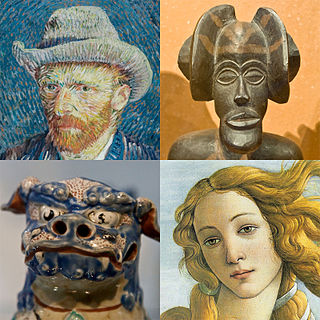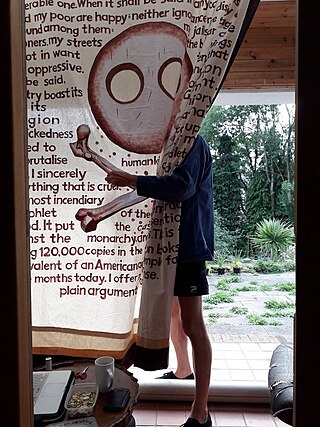
Art is a diverse range of human activity and its resulting product that involves creative or imaginative talent generally expressive of technical proficiency, beauty, emotional power, or conceptual ideas.
Aesthetics is the branch of philosophy concerned with the nature of beauty and the nature of taste; and functions as the philosophy of art. Aesthetics examines the philosophy of aesthetic value, which is determined by critical judgments of artistic taste; thus, the function of aesthetics is the "critical reflection on art, culture and nature".
Alternative media are media sources that differ from established or dominant types of media in terms of their content, production, or distribution. Sometimes the term independent media is used as a synonym, indicating independence from large media corporations, but generally independent media is used to describe a different meaning around freedom of the press and independence from government control. Alternative media does not refer to a specific format and may be inclusive of print, audio, film/video, online/digital and street art, among others. Some examples include the counter-culture zines of the 1960s, ethnic and indigenous media such as the First People's television network in Canada, and more recently online open publishing journalism sites such as Indymedia.

Museology is the study of museums. It explores the history of museums and their role in society, as well as the activities they engage in, including curating, preservation, public programming, and education.

The feminist art movement in the United States began in the early 1970s and sought to promote the study, creation, understanding and promotion of women's art. First-generation feminist artists include Judy Chicago, Miriam Schapiro, Suzanne Lacy, Judith Bernstein, Sheila de Bretteville, Mary Beth Edelson, Carolee Schneeman, Rachel Rosenthal, and many other women. They were part of the Feminist art movement in the United States in the early 1970s to develop feminist writing and art. The movement spread quickly through museum protests in both New York and Los Angeles, via an early network called W.E.B. that disseminated news of feminist art activities from 1971 to 1973 in a nationally circulated newsletter, and at conferences such as the West Coast Women's Artists Conference held at California Institute of the Arts and the Conference of Women in the Visual Arts, at the Corcoran School of Art in Washington, D.C..
The conservation and restoration of new media art is the study and practice of techniques for sustaining new media art created using from materials such as digital, biological, performative, and other variable media.
Vasif Kortun is a curator, writer and educator in the field of contemporary art, its institutions, and exhibition practices. Kortun served as the founding director of several international institutions, including SALT, Platform Garanti Contemporary Art Center, Proje4L, and the Museum of the Center for Curatorial Studies, Bard College. In 2006, he received the Award for Curatorial Excellence from the Center for Curatorial Studies for his "experimental approach and openness to new ideas to challenge the contemporary art world and push its parameters beyond national or international, local or global developments." Kortun has written extensively on contemporary art and visual culture in Turkey for publications and periodicals internationally. He currently lives in Ayvalık, a seaside town on the northwestern Aegean coast of Turkey.

Sal Randolph is an American artist and theorist who works with issues of gift-giving, money, alternate economies, and social architecture. She founded the non-curated sound-exchange web project Opsound, which functions through the use of music released exclusively under a copyleft license, and has been cited by Lawrence Lessig as an example of how Creative Commons works to enable artists to collaborate more freely and build on each other's work. Other large-scale, collaborative projects created and implemented by Randolph include Free Manifesta and The Free Biennial, in which several hundred artists presented their work in free and open shows in New York's and Frankfurt am Main's public spaces. Artists participating in those projects included Christophe Bruno, Aram Saroyan, Swoon (artist), and Michael Cunningham, among many others.
I am a Curator was a process-based exhibition project by artist Per Hüttner that took place at Chisenhale Gallery, London, UK, 5 November – 14 December 2003. During the period individual or groups of people with no experience of exhibition making created 36 exhibitions and briefly got to experience the process putting together a contemporary art show. They had artwork by 57 artists to interact with. The project stirred a lot of controversy in the art world at the time. The most common critique was that the project suggested that curation and exhibition making is easy Hüttner responded to this by writing: "the goal of the project was to inspire a more diverse and profound discussion about the meaning of artworks, exhibitions and the role of the artist." Over the years, the project has gained recognition and has been hailed as being ahead of its time and has been widely appreciated for its visionary qualities in readers on curation and research on the subject of art and exhibition making.
The Berkeley Center for New Media (BCNM) is a research, teaching, and public events program at UC Berkeley. Its mission is to critically analyze and help shape developments in new media from cross-disciplinary and global perspectives that emphasize humanities and the public interest. Founded in 2004 by Linda Williams, Ken Goldberg, Greg Niemeyer, Whitney Davis, and Cathy Koshland, the organization seeks to study new media from three disciplinary perspectives, the humanities, the arts, and technology. BCNM awards Designated Emphasis Degrees in New Media and Masters Certificates to graduate students and Undergraduate Certificates to undergraduate students at UC Berkeley.
Manifesta, also known as the European Nomadic Biennial, is a European pan-regional contemporary cultural biennale.

Authenticity in art is manifest in the different ways that a work of art, or an artistic performance, can be considered authentic. The initial distinction is between nominal authenticity and expressive authenticity. In the first sense, nominal authenticity is the correct identification of the author of a work of art; of how closely an actor or an actress interprets a role in a stageplay as written by the playwright; of how well a musician's performance of an artistic composition corresponds to the composer's intention; and how closely an objet d’art conforms to the artistic traditions of its genre. In the second sense, expressive authenticity is how much the work of art possesses inherent authority of and about its subject, and how much of the artist's intent is in the work of art.

David Garner is a Welsh installation artist known for his use of found objects and overtly political themes.
The Art Assignment is a PBS Digital Studios webseries focused on contemporary art that debuted in February 2014. The Art Assignment is hosted by Sarah Urist Green who was a curator of contemporary art for the Indianapolis Museum of Art from 2007 to 2013.
Social practice or socially engaged practice in the arts focuses on community engagement through a range of art media, human interaction and social discourse. While the term social practice has been used in the social sciences to refer to a fundamental property of human interaction, it has also been used to describe community-based arts practices such as relational aesthetics, new genre public art, socially engaged art, dialogical art, participatory art, and ecosocial immersionism.

Barbara Vanderlinden is a Belgian art historian, curator, and director.
Barbara Meneley is a contemporary Canadian visual artist and educator based in Regina, Saskatchewan. She is known for her new media art, which brings together elements of media, installation art and performance art in solo and curated group exhibitions throughout Canada.

Sigrid Pawelke is a German curator and a performance and art historian, regarded as one of the leading experts of the Bauhaus Stage and its influences on the arts in North America. In 2015 she was part of the Black Mountain show at the Hamburger Bahnhof, Museum of Contemporary Art Berlin, contributing fifteen film interviews of former Black Mountain students. In 2019 she created with Dimitri Chamblas “Unlimited Bodies”, a seven-day interdisciplinary experiment inspired by the radical pedagogies of the Bauhaus for the biennial “PERFORMA 19” in New York.
Protey Temen is a contemporary artist, a multi-disciplinary media-artist whose works are often performed in the form of total installations, including graphics, video-art, sculpture, and painting. He is a teacher at the Design School of the National research university the Higher School of Economics.
Michael Takeo Magruder is an American/British new media and digital artist who uses digital technologies to create work that connects with real-time data, virtual worlds and networked mobile devices.








